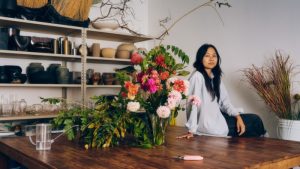The new dreamcatchers of British Columbia
In a cedarwood cabin on the remote archipelago of Haida Gwaii, British Columbia, a hot tub babbles away on the balcony, and a soft forest light gilds an interior that’s dressed with bespoke easy chairs and Indigenous objets d’art. From the wall, a 2m-wide reproduction of a black-and-white photograph surveys the scene. The image was taken at nearby HIGaagilda, a town better known by its colonial name, Skidegate, in 1876, and depicts 20 women wearing ceremonial blankets, feathered headdresses and the Haida people’s characteristic conical, cedar-bark hats. It captures the last day that the Haida were allowed to dress in their clan regalia before it was permanently confiscated under the 1876 Indian Act. This colonial legislation suppressed Indigenous practices and languages, and led to the creation of “Indian” reservations and residential schools, where First Nations children were removed, notoriously, to be raised under “civilising” Christian eyes.


Today, following the landmark 2023 Nang K’uula/Nang K’úulaas Recognition Agreement with the Canadian government, the Haida Nation once more governs this forested and whale-encircled Pacific archipelago, which was known as the Queen Charlotte islands from 1787 to 2010. The agreement brings everything from Haida Gwaii forestry and fisheries to tourism under Indigenous control. It’s a model for Indigenous self-governance in a global context in which income from Indigenous-themed tourism, a category worth around $16bn in the US and Canada, only indifferently filters down to the peoples themselves.
Haida House came under Haida Nation control in 2010. Today, this former bear-hunting lodge is a luxury nature retreat, with smart double rooms in the original lodge building plus 12 two-bedroom cabins inspired by traditional Haida longhouses whose copper roofs reference the ceremonial shields that signify Haida wealth. As elsewhere on Haida Gwaii, tourists here are asked to take the “Haida Pledge”: an agreement to respect a land where the native peoples believe all nature is one. This extends from the ocean floor that gives up its prized clam and abalone “wash-up” to the forested mountain tops above. It’s a philosophy the Haida call Gina ’Waadluxan KilGuhlGa, or “talking about everything”.


During my childhood, I often visited my Canadian family in northern Ontario, a region peppered with reservations and unceded territories (First Nations land that was never given up to the Crown). Hundreds of thousands of Britons migrated to Canada in the early- and mid-20th century, among them three generations of my Cornish tin-miner relatives, who settled in towns with names such as Falconbridge and Wahnapitae, and lived side by side with Indigenous people from Odawa, Ojibwe, Cree and Moose Cree tribes. On visits to see my uncle Leonard, a retired operations worker from Inco nickel mine, I’d tour the strange lunar and lake-dotted landscapes of the open-cast mine sites and pitch in with community potlucks at the local curling rink. This latest trip is a chance to reconnect with Angela Recollet, an Ojibwe of the Wahnapitae First Nation and once a childhood friend.
Now the CEO at a Canadian state healthcare centre dedicated to First Nations peoples, she tells me she welcomes the arrival of a formal Indigenous-run tourism sector – with certain caveats. “Hosting is sacred for First Nations people, and all people who enter our spaces – whether our homes, or places in nature held dear to us – are also considered sacred to us by extension, so tourists should behave with respect if they are given this honour.”


Through the 2000s, Recollet offered cultural tours for white tourists at her Sudbury clapboard home: a bright spot in an Indigenous tourism pantheon that, in those days, was all Caucasian-run smudging rituals (a spiritually cleansing plant-burning ceremony) and mass-produced totem pole and dreamcatcher souvenirs. This was before nearby Wiikwemkoong became famous as the birthplace of Joseph Shawana, an Indigenous chef whose Toronto restaurant Kū-Kŭm Kitchen catalysed First Nations haute cuisine in dishes such as tartare of seal loin, elk cooked sous vide and pine-needle sorbet.
On Haida Gwaii, I spend a pleasant day trekking the island’s lush temperate rainforests, with their verdant mossy understories, and a maritime coast where marine geysers exhale their florid jets. Later, I share a meal at Keenawaii’s Kitchen in Skidegate with Marni York, a Haida cultural guide who, with her shark’s tooth necklaces and cocked cedarwood hat, has the outdoorsy energy of a Haida Crocodile Dundee.
As Roberta Olson serves a delicate decoction of salmon jerky, venison and k’aaw, a prized Haida delicacy of herring roe spawn on kelp, York tells a hair-raising tale about being tossed off a dinghy by a humpback whale. She stops, k’aaw poised on fork, to tell us of the moment she knew the Haida’s “dark times” – from the smallpox epidemic that killed 80 per cent of the archipelago’s population, to the Indian Act that “killed the Haida’s soul” – were coming to an end. It was in 1969 when a monumental totem pole was raised in Old Massett Village for the first time in nearly a century. From the 1800s, these 20m painted monuments – which serve as domestic decoration in the form of “house poles”, or are ancestor commemoration – were plundered and shipped off to museums in Vancouver, London and Berlin. The day the first pole returned, York was a kid and it was a momentous affair, with hundreds of young Haida pulling ropes to erect the pole while elders in traditional dress looked on. “Yup, that was when we began to see the light,” York says, taking a bite of k’aaw as she wipes away a tear.


My next stop is Klahoose Wilderness Resort, which involves a seaplane flight from Vancouver over brilliant blue waters, and a boat ride through the islands and tributaries of Desolation Sound. The resort is the dernier cri in First Nations luxury tourism. In 2020 it was bought by the Klahoose, one of the three groups comprising the Mainland Comox peoples (along with Homalco and Tla’amin), who have occupied the islands and inlets of the Strait of Georgia for 13 millennia, and, according to their oral traditions, are the descendants of the survivors of the Great Flood. Attractions include grizzly- and eagle-spotting; First Nations fine dining; cultural immersion in Indigenous music, ceremony and art; and watersports on Desolation Sound, where seals and whales bob next to guests as they paddle kayaks and swim at the dock by the resort’s cedarwood sauna. On a grizzly-spotting tour the next morning, we putter on a boat past glacial waterfalls. I chat to staff member Riley, a 20-year-old of Tla’amin descent who is keen to forge a career in tourism. Riley recently took an entrepreneurship course with Indigenous Commmunity for Leadership and Development, which represents and incubates Indigenous-owned tourism businesses. “Kids like me used to think that logging was the safe bet but tourism is where the possibilities are now,” he smiles. We pass a bay that Riley tells us is occupied by an American billionaire who made his money in tech in the 1990s, then stop at a rock face embellished in blood-red cave art resembling a bison and a leaping fish. “Thousands of years old, that,” Riley says. “Cool, hey?”
Dinner that night is prawns caught on the Sound, with a floral pinot blanc from Nk’Mip, the most successful of a new generation of First Nations-run vineyards. Later, I sit and weave yellow cedar-bark bracelets with Sofia Nybida, who is working the season on vacation from art school. There’s a renewed interest in Indigenous arts and crafts, with antique chiefs’ “wearing blankets” from the 1800s selling for upwards of $125,000 (and $1.5mn in one auction in California). For Sofia, this is a mixing blessing. “It’s amazing that carvers and weavers can make a good living,” she says, “but many of our items, like feather headdresses and carved bentwood boxes, should not be bought and sold.”
On my last night at Klahoose, after a day trekking with my bear klaxon and grizzly spray, I relax on the balcony with spiced tuna appetisers and chat to Riley about his plans. Riley and girlfriend Carol are soon to join a ceremonial canoe journey along the Pacific currents to meet up with other First Nations folk in Muckleshoot. These traditional gatherings resumed a few years ago and have blossomed into a summer festival on the Pacific swell. “It’s like a coming-of-age thing,” he says, “and coming into our Indigenous identity, too.”


Back in Vancouver the city bristles with expressions of a newly confident First Nations entrepreneurial class. Salmon n’ Bannock, Vancouver’s most famous First Nations restaurant, which turns out fusion favourites such as smoked sablefish on corn polenta and bison burgers, now has a shiny new branch at Vancouver Airport.
Bed for my final few nights in Vancouver is Skwachàys Lodge, a hospitality social enterprise, where income subsidises accommodation for First Nations artists who occupy the apartments in the smart West Pender Street block. The top floor at Skwachàys Lodge features a rooftop sauna, and breakfast is both Western Canadian and Indigenous: a highlight are the fist-sized rolls of the staple First Nations fried-wheat bread, bannock.
As tourism booms, the battle for Indigenous culture continues to draw controversy. International institutions, including the British Museum, still hold contested carvings and textiles; spiritual tours need to be staged in a way that’s sensitive to both Indigenous cultures and Canadian wildlife. Hanging in the breakfast room at Skwachàys Lodge is an oil painting of a police car in a spectral twilight. Titled Starlight Tour, it’s the work of Anishinaabe artist and former lodge resident Mike Alexander. “Starlight tours” were a practice of some members of the Saskatoon Police Service for three decades from the 1970s, involving picking up Indigenous people at night and dumping them in the countryside. The “tours” lead to the deaths of at least three men from probable hypothermia: Rodney Naistus, Lawrence Wegner and Neil Stonechild. An article by Odette Auger, mounted beside the painting, reads: “We have lived in darkness. Now is the time to heal.”
Sally Howard travelled as a guest of Original Travel. Its Indigenous Canadian itineraries cost from £7,350pp based on two people sharing, including return flights, transfers and 10 nights’ accommodation with three nights full-board at Haida House and three nights full-board at Klahoose Wilderness Resort, with all activities included at each
#dreamcatchers #British #Columbia







